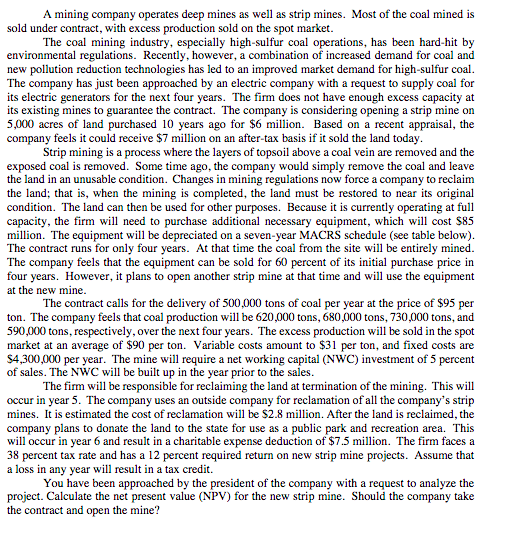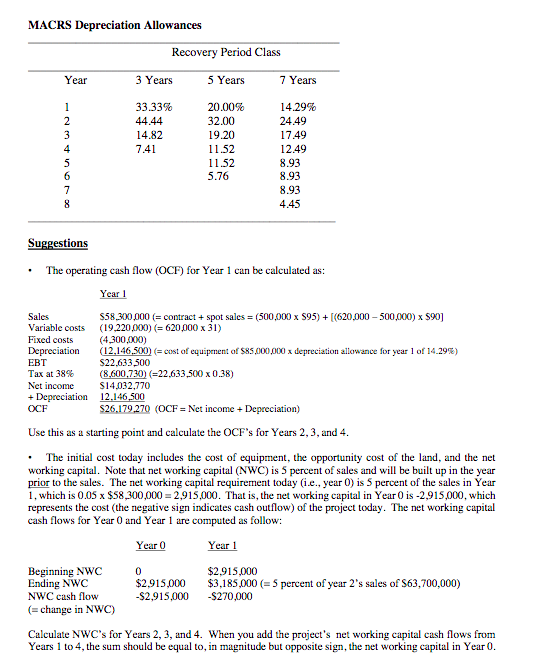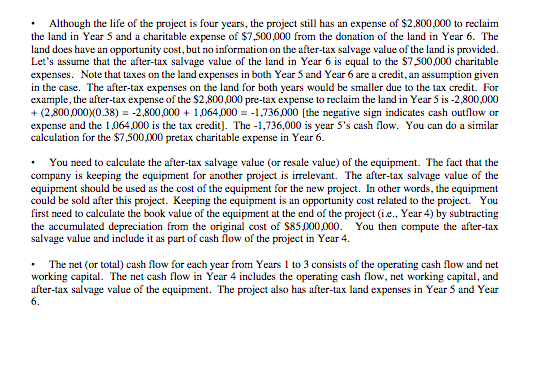


A mining company operates deep mines as well as strip mines. Most of the coal mined is sold under contract, with excess production sold on the spot market. The coal mining industry, especially high-sulfur coal operations, has been hard-hit by environmental regulations. Recently, however, a combination of increased demand for coal and new pollution reduction technologies has led to an improved market demand for high-sulfur coal. The company has just been approached by an electric company with a request to supply coal for its electric generators for the next four years. The firm does not have enough excess capacity at its existing mines to guarantee the contract. The company is considering opening a strip mine on 5,000 acres of land purchased 10 years ago for $6 million. Based on a recent appraisal, the company feels it could receive $7 million on an after-tax basis if it sold the land today. Strip mining is a process where the layers of topsoil above a coal vein are removed and the exposed coal is removed. Some time ago, the company would simply remove the coal and leave the land in an unusable condition. Changes in mining regulations now force a company to reclaim the land; that is, when the mining is completed, the land must be restored to near its original condition. The land can then be used for other purposes. Because it is currently operating at full capacity, the firm will need to purchase additional necessary equipment, which will cost $85 million. The equipment will be depreciated on a seven-year MACRS schedule (see table below). The contract runs for only four years. At that time the coal from the site will be entirely mined. The company feels that the equipment can be sold for 60 percent of its initial purchase price in four years. However, it plans to open another strip mine at that time and will use the equipment at the new mine. The contract calls for the delivery of 500.000 tons of coal per year at the price of $95 per ton. The company feels that coal production will be 620,000 tons, 680,000 tons, 730,000 tons, and 590,000 tons, respectively, over the next four years. The excess production will be sold in the spot market at an average of $90 per ton. Variable costs amount to $31 per ton, and fixed costs are $4,300,000 per year. The mine will require a networking capital (NWC) investment of 5 percent of sales. The NWC will be built up in the year prior to the sales. The firm will be responsible for reclaiming the land at termination of the mining. This will occur in year 5. The company uses an outside company for reclamation of all the company's strip mines. It is estimated the cost of reclamation will be $2.8 million. After the land is reclaimed, the company plans to donate the land to the state for use as a public park and recreation area. This will occur in year 6 and result in a charitable expense deduction of $7.5 million. The firm faces a 38 percent tax rate and has a 12 percent required return on new strip mine projects. Assume that a loss in any year will result in a tax credit. You have been approached by the president of the company with a request to analyze the project. Calculate the net present value (NPV) for the new strip mine. Should the company take the contract and open the mine? MACRS Depreciation Allowances Recovery Period Class Year 3 Years 7 Years 33.33% 44.44 14.82 7.41 1 2 3 4 5 6 7 8 5 Years 20.00% 32.00 19.20 11.52 11.52 5.76 14.29% 24.49 17.49 12.49 8.93 8.93 8.93 4.45 Suggestions The operating cash flow (OCF) for Year 1 can be calculated as: Year Sales $58.300.000 (= contract + spot sales = (500,000 x 595) + (620,000 - 500,000) x $90] Variable costs (19.220.000) (= 620.000 x 31) Fixed costs (4,300,000) Depreciation 12,146,500) = cost of equipment of $85,000,000 x depreciation allowance for year 1 of 14.29%) EBT $22.633,500 Tax at 38% (8.600,730) (=22,633,500 x 0.38) Net income S14,032.770 + Depreciation 12.146,500 OCF $26.179,270 (OCF = Net income + Depreciation) Use this as a starting point and calculate the OCF's for Years 2, 3, and 4. The initial cost today includes the cost of equipment, the opportunity cost of the land, and the net working capital. Note that net working capital (NWC) is 5 percent of sales and will be built up in the year prior to the sales. The net working capital requirement today (i.e., year 0) is 5 percent of the sales in Year 1, which is 0.05 x $58,300,000 = 2,915,000. That is the networking capital in Year Ois -2,915,000, which represents the cost (the negative sign indicates cash outflow) of the project today. The net working capital cash flows for Year 0 and Year 1 are computed as follow: Year 0 Year 1 Beginning NWC 0 $2.915,000 Ending NWC $2.915,000 $3,185.000 (= 5 percent of year 2's sales of $63,700,000) NWC cash flow -$2,915,000 -$270,000 (= change in NWC) Calculate NWC's for Years 2, 3, and 4. When you add the project's net working capital cash flows from Years 1 to 4, the sum should be equal to, in magnitude but opposite sign, the net working capital in Year 0. Although the life of the project is four years, the project still has an expense of $2,800,000 to reclaim the land in Year 5 and a charitable expense of $7,500,000 from the donation of the land in Year 6. The land does have an opportunity cost, but no information on the after-tax salvage value of the land is provided. Let's assume that the after-tax salvage value of the land in Year 6 is equal to the $7,500,000 charitable expenses. Note that taxes on the land expenses in both Year 5 and Year 6 are a credit, an assumption given in the case. The after-tax expenses on the land for both years would be smaller due to the tax credit. For example, the after-tax expense of the $2,800,000 pre-tax expense to reclaim the land in Year 5 is -2,800,000 +(2,800,000)(0.38) = -2,800,000 + 1,064,000 = -1,736,000 (the negative sign indicates cash outflow or expense and the 1,064,000 is the tax credit). The -1,736,000 is year 5's cash flow. You can do a similar calculation for the $7,500,000 pretax charitable expense in Year 6. You need to calculate the after-tax salvage value (or resale value) of the equipment. The fact that the company is keeping the equipment for another project is irrelevant. The after-tax salvage value of the equipment should be used as the cost of the equipment for the new project. In other words, the equipment could be sold after this project. Keeping the equipment is an opportunity cost related to the project. You first need to calculate the book value of the equipment at the end of the project (i.e., Year 4) by subtracting the accumulated depreciation from the original cost of $85.000.000. You then compute the after-tax salvage value and include it as part of cash flow of the project in Year 4. The net (or total) cash flow for each year from Years 1 to 3 consists of the operating cash flow and net working capital. The net cash flow in Year 4 includes the operating cash flow, net working capital, and after-tax salvage value of the equipment. The project also has after-tax land expenses in Year 5 and Year . 6









